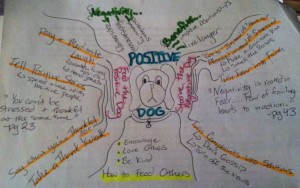An Idea Mapping Success Blogs Weblog
Idea Map 463 – The Positive Dog
30Jul2014 Filed under: Book Reviews, Idea Mapping Example, Mind Mapping Examples Author: Jamie Nast Meet James White. He uses Idea Mapping to amplify self-help reading. I’ll let him tell you the rest:
Meet James White. He uses Idea Mapping to amplify self-help reading. I’ll let him tell you the rest:
“I’m a fan of self-help books but I often come across the problem that I can’t remember everything I read. To solve this problem, I started creating mind maps to outline important quotes, key pages that I might want to visit again, and a general overview of the book.
Creating idea maps also helps me visualize the information and key points, and thereby retain them better and longer. Not only that, but they can be kept in the front of the book or in a binder and used as a point of reference down the road, to quickly recall the information.
You can use idea maps to draw out whole books or even just individual chapters. You can also include page numbers with specific points, quotes or reference figures in order to find that particular piece of information quickly once again.
I’ve created a very basic idea map example above, which maps out a self-help book about keeping a positive outlook in life. I read The Positive Dog as a requirement for one of my online college courses. I drew this idea map back then so that I could remember the important points and any added take-aways to help me stay positive years later.
If you are someone who has a difficult time remembering what they read, idea maps are a perfect substitution for taking notes. The process of both creating the idea map and then reviewing that map will help you to retain information more effectively.”
James is a freelance writer, photographer and part-time content creator. Read more articles from James on his blog InfoBros and follow him on Twitter @JGtheSavage.
Idea Mapping Blog
The purpose of this blog is to share idea mapping examples and related learning from my Idea Mapping, Memory, Speed Reading, and Certification Workshops. This blog is dedicated to my Certified Idea Mapping Instructors, my clients, Mind Mapping and Idea Mapping practitioners around the globe.
![[Ask]](http://ideamapping.ideamappingsuccess.com/IdeaMappingBlogs/wp-content/plugins/bookmarkify/ask.png)
![[del.icio.us]](http://ideamapping.ideamappingsuccess.com/IdeaMappingBlogs/wp-content/plugins/bookmarkify/delicious.png)
![[Digg]](http://ideamapping.ideamappingsuccess.com/IdeaMappingBlogs/wp-content/plugins/bookmarkify/digg.png)
![[Facebook]](http://ideamapping.ideamappingsuccess.com/IdeaMappingBlogs/wp-content/plugins/bookmarkify/facebook.png)
![[Google]](http://ideamapping.ideamappingsuccess.com/IdeaMappingBlogs/wp-content/plugins/bookmarkify/google.png)
![[MySpace]](http://ideamapping.ideamappingsuccess.com/IdeaMappingBlogs/wp-content/plugins/bookmarkify/myspace.png)
![[Slashdot]](http://ideamapping.ideamappingsuccess.com/IdeaMappingBlogs/wp-content/plugins/bookmarkify/slashdot.png)
![[Sphinn]](http://ideamapping.ideamappingsuccess.com/IdeaMappingBlogs/wp-content/plugins/bookmarkify/sphinn.png)
![[StumbleUpon]](http://ideamapping.ideamappingsuccess.com/IdeaMappingBlogs/wp-content/plugins/bookmarkify/stumbleupon.png)
![[Technorati]](http://ideamapping.ideamappingsuccess.com/IdeaMappingBlogs/wp-content/plugins/bookmarkify/technorati.png)
![[ThisNext]](http://ideamapping.ideamappingsuccess.com/IdeaMappingBlogs/wp-content/plugins/bookmarkify/thisnext.png)
![[Twitter]](http://ideamapping.ideamappingsuccess.com/IdeaMappingBlogs/wp-content/plugins/bookmarkify/twitter.png)
![[Webride]](http://ideamapping.ideamappingsuccess.com/IdeaMappingBlogs/wp-content/plugins/bookmarkify/webride.png)
![[Email]](http://ideamapping.ideamappingsuccess.com/IdeaMappingBlogs/wp-content/plugins/bookmarkify/email.png)
Leave a reply